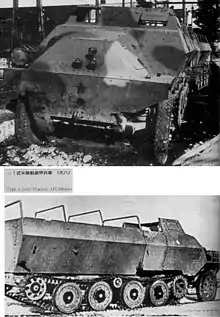Type 1 Ho-Ha
The Type 1 Ho-Ha (一式半装軌装甲兵車 ホハ, Ichi-shiki han-sōki sōkō-heisha hoha) was a half-track armoured personnel carrier (APC) used in limited numbers by the Imperial Japanese Army (IJA) during World War II.

| Type 1 Ho-Ha | |
|---|---|
 Type 1 Ho-Ha | |
| Type | half-track armoured personnel carrier |
| Place of origin | Empire of Japan |
| Service history | |
| Wars | World War II |
| Production history | |
| Designed | 1941[1] |
| Manufacturer | Hino Motors |
| Produced | 1944–? |
| Specifications (Type 1 Ho-Ha[2]) | |
| Mass | 6.5 tonnes (7.2 tons)[2] |
| Length | 6.1 m (20 ft 0 in)[3] |
| Width | 2.1 m (6 ft 11 in)[3] |
| Height | 2.51 m (8 ft 3 in)[2] |
| Crew | 2 + 13 passengers[4] |
| Armor | max 8 mm[3] |
Main armament | 3 × 7.7 mm Type 97 light machine guns[2] |
| Engine | Diesel engine 134 PS at 2,000 rpm[3] |
Operational range | 300 km[3] |
| Maximum speed | 50 km/h (31 mph)[3] |
Development and history
The Type 1 Ho-Ha was developed in 1941 as a result of a request from the army for a vehicle that could be used to transport a squad of infantry to the battlefield protected from enemy small arms fire. Despite experiences of the Second Sino-Japanese War, armored personnel carriers were viewed as too slow compared to wheeled trucks and there was not much effort for their development in the army.[1]
Production began in 1944 with the Type 1 Ho-Ha being an addition to the Type 1 Ho-Ki, an unrelated, yet similarly named armored tracked personnel carrier.[1][2] The half-tracked Type 1 Ho-Ha was built by Hino Motors in unknown quantities.[2][5]
Design
The Type 1 Ho-Ha was based on the German Sd.Kfz. 251/1 (known popularly as Hanomag), the main armoured personnel carrier of the German Army, but did not use the overlapped and interleaved road wheels of the German design's suspension.[1][5] Further, it had a "vertical rear plate with a door", akin to the American M3 Half-track; however, the door itself was a copy of the German "two-leaf" design.[5]
The Type 1 Ho-Ha had a pair of road wheels in front, supported by a pair of short caterpillar tracks to the rear.[1] It was equipped with a tow coupling in the front and a towing hitch at the rear to haul artillery or a supply trailer. The maximum armor thickness was 8 mm with sloping armor plates. As with the Type 1 Ho-Ki, the hull was welded construction and it was "open-topped".[6]
The Type 1 Ho-Ha carried three Type 97 light machine guns as standard armament, one on each side, just to the rear of the driver's compartment and a third mounted to the rear as an anti-aircraft weapon.[1] All of these weapons had constricted firing arcs, which made firing directly forward or directly rearward impossible.[1]
Combat record and post-war
The Type 1 Ho-Ha was initially deployed to China for operations in the ongoing Second Sino-Japanese War, but never in any great numbers. It was later deployed with the Japanese reinforcements in the Battle of the Philippines in 1944. Post-war, some Type 1 Ho-Ha half-tracks were modified by cutting off the rear armored section and replacing it with a flat bed. They were then used for reconstruction work in areas of the country.[7]
Footnotes
- Japanese Armored Vehicles of the Second World War
- Taki's Imperial Japanese Army: Type 1 "Ho-Ha"
- Tomczyk 2003, p. 64.
- Tomczyk 2003, p. 63.
- Tomczyk 2003, p. 57.
- Tomczyk 2003, pp. 58, 65.
- Zaloga 2007, p. 45.
References
- Foss, Christopher F (2002). The Encyclopedia of Tanks and Armored Fighting Vehicles: The Comprehensive Guide to over 900 Armored Fighting Vehicles from 1915 to the Present Day. Thunder Bay Press. ISBN 1-57145-806-9.
- Tomczyk, Andrzej (2003). Japanese Armor Vol. 3. AJ Press. ISBN 978-8372371287.
- Zaloga, Steven J. (2007). Japanese Tanks 1939–45. Osprey. ISBN 978-1-8460-3091-8.